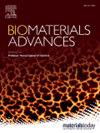用于生物电子和组织再生功能的石墨烯增强聚乳酸纳米复合材料的加工和性能。
IF 5.5
2区 医学
Q2 MATERIALS SCIENCE, BIOMATERIALS
Materials Science & Engineering C-Materials for Biological Applications
Pub Date : 2024-11-08
DOI:10.1016/j.bioadv.2024.214113
引用次数: 0
摘要
一种原位聚合物溶液加工方法能够高效生产出具有显著物理和生物医学特性的均匀石墨烯增强聚乳酸(G-PLA)纳米复合材料。该方法通过在剥离过程中产生石墨烯悬挂键和缺陷,有效增强了石墨烯和聚乳酸之间的界面结合。因此,G-PLA 的杨氏模量提高了 182%,拉伸强度提高了 85%。仅添加 0.5 wt% 的石墨烯就能将复合材料的接触角从 75.3 降低到 70.4,并将其透氧性降低 23%。亲水性、密封性和机械性能的改善使 G-PLA 成为植入式生物电子器件的绝佳封装材料。此外,还通过在合成的 G-PLA 上培养干细胞,从组织学角度研究了复合材料的表面属性和细胞在材料-组织界面上的行为。G-PLA复合材料能显著促进细胞增殖并调节细胞向血管内皮分化,从而实现植入物表面的组织再生,恢复受伤组织。由于石墨烯能减缓聚乳酸末端羧酸基团诱导的自催化链分裂,G-PLA 纳米复合材料的降解速率也能得到调节。因此,这种由石墨烯负载调控物理和生物医学特性的 G-PLA 纳米复合材料可用于开发具有传感和组织工程功能的下一代植入式电子系统,以满足诸如监测骨折愈合或颅内压的植入式传感器等复杂应用的需要。本文章由计算机程序翻译,如有差异,请以英文原文为准。

Processing and properties of graphene-reinforced polylactic acid nanocomposites for bioelectronic and tissue regenerative functions
An in-situ polymer-solution-processing approach enables the efficient production of uniform graphene-reinforced polylactic acid (G-PLA) nanocomposites with notable physical and biomedical properties. The approach effectively enhances the interfacial bonding between graphene and PLA by creating graphene dangling bonds and defects during exfoliation. As a result, an 182 % increase in Young's modulus and an 85 % increase in tensile strength can be achieved in G-PLA. Only 0.5 wt% graphene addition can reduce the contact angle of the composite from 75.3 to 70.4 and reduce its oxygen permeability by 23 %. The improved hydrophilicity, hermeticity, and mechanical properties make G-PLA an excellent encapsulation material for implantable bioelectronics. Moreover, the composite surface attributes and cell behaviors at the material-tissue interface are investigated histologically through the culture of stem cells on as-synthesized G-PLA. G-PLA composites can significantly boost cell proliferation and regulate cell differentiation towards vascular endothelium, offering tissue regeneration at the surface of implants to recover the injured tissues. The degradation rate of G-PLA nanocomposite can also be regulated since the graphene slows down the autocatalytic chain splitting induced by the terminal carboxylic acid groups of PLA. Therefore, such G-PLA nanocomposites with physical and biomedical properties regulated by graphene loading enable the development of next-generation implantable electronic systems providing both sensing and tissue engineering functions for complicated applications such as implanted sensors monitoring the healing of fractured bones or intracranial pressure.
求助全文
通过发布文献求助,成功后即可免费获取论文全文。
去求助
来源期刊
CiteScore
17.80
自引率
0.00%
发文量
501
审稿时长
27 days
期刊介绍:
Biomaterials Advances, previously known as Materials Science and Engineering: C-Materials for Biological Applications (P-ISSN: 0928-4931, E-ISSN: 1873-0191). Includes topics at the interface of the biomedical sciences and materials engineering. These topics include:
• Bioinspired and biomimetic materials for medical applications
• Materials of biological origin for medical applications
• Materials for "active" medical applications
• Self-assembling and self-healing materials for medical applications
• "Smart" (i.e., stimulus-response) materials for medical applications
• Ceramic, metallic, polymeric, and composite materials for medical applications
• Materials for in vivo sensing
• Materials for in vivo imaging
• Materials for delivery of pharmacologic agents and vaccines
• Novel approaches for characterizing and modeling materials for medical applications
Manuscripts on biological topics without a materials science component, or manuscripts on materials science without biological applications, will not be considered for publication in Materials Science and Engineering C. New submissions are first assessed for language, scope and originality (plagiarism check) and can be desk rejected before review if they need English language improvements, are out of scope or present excessive duplication with published sources.
Biomaterials Advances sits within Elsevier''s biomaterials science portfolio alongside Biomaterials, Materials Today Bio and Biomaterials and Biosystems. As part of the broader Materials Today family, Biomaterials Advances offers authors rigorous peer review, rapid decisions, and high visibility. We look forward to receiving your submissions!

 求助内容:
求助内容: 应助结果提醒方式:
应助结果提醒方式:


